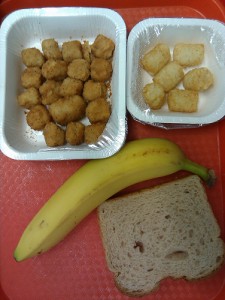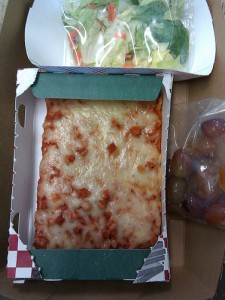Join us for the event here (a slide show).

The more things change the more they stay the same!
School lunch, when I was growing up, actually got cooked/baked/served in the same building as my classrooms and gymnasium. And in the 1950s, I ate my share of “mystery meat” and odd concoctions labeled “vegetables” – like an awful pickled corn salad that I despised.
That said, we still got food that was fresher and better for us than some of the stuff kids have to face today.
This week’s Whole Food Market’s Consumer Conflict Speaker Series focused on healthy eating in our schools. The panel consisted of Chef Eric Tanaka, executive chef at the renowned Tom Douglas Restaurants, Stacey Sobell, Farm to School Manager for Ecotrust, Nona Evans, Executive Director of Whole Kids Foundation, and Sarah Wu, teacher in the Chicago School District and author of Fed Up With Lunch, a blog chronicling her experience eating school lunches every day for a year.
In just a couple of sentences we can sum up the conversation:

1. Kid’s lunches are pretty awful for several reasons: budget/cost – schools have about $1.25 PER MEAL to fund lunch; convenience – many schools serve prepared lunches from a central commissary; and procurement policies make it difficult to buy fresh meat and produce from local growers.
2. There is hope! More schools are getting involved with Farm to School programs to facilitate local procurement of fresh products. And organizations like the Whole Kids Foundation are funding special programs like lunchroom salad bars and school gardens.
3. Kids will experiment with new foods and often choose good food if given the option.
4. It is critical that elected officials – local, state, and federal – understand how important it is that these programs be funded. Especially since school meals are sometimes the only meals some children get every day.
States like Washington and Minnesota (among many others) are working to implement farm to school programs. In Washington, a 2011 survey by the University of Washington, found that:
- Two third of school districts would be willing to purchase fruits and vegetables from a local source.
- About half (49%) of school districts reported having made a purchase directly from a local farm in 2011 as compared to only one third (33%) of districts made direct purchase in 2007.
- The majority (85%) of districts have positive experiences in purchasing Washington-grown food directly from farms.
- All school districts that said that they had purchased locally in the past responded stated that they would purchase Washington grown products directly from farmers/producers again.
- Four of the top 10 fruits and vegetables that were most frequently purchased by school districts were also part of the top 10 commodity crops grown in Washington.
- Over two third of school districts would be willing to work with farmers to ensure schools could obtain foods they need.
In Minnesota, schools serving more than 558,000 students (more than 68% of the state’s K-12 student population) are engaged in Farm to School programs. A survey by the Minnesota School Nutrition Association found that:
- 53% of participating districts indicate that they developed closer relationships with farmers in their area over the past year.
- 43% of participating food service leaders perceive that student consumption of fruits and vegetables increases when these foods are part of their Farm to School program.
- Twenty-seven different Farm to School foods were used by more than 10 districts in 2011, up from just 11 F2S foods that were used this widely in 2009, including apples, cucumbers, tomatoes, watermelon, potatoes, winter squash, peppers, carrots, cantaloupe and sweet corn.
These types of programs, both state level and federal, not only provide more fresh healthy food for school kids, they also create new markets and economic opportunities for small and local growers and producers. Let’s see how far this can be expanded and – as kids learn how to enjoy more foods like homemade hummus, sautéed kale with brown rice, and other “exotic” menus created by chefs like Eric Tanaka.
Resources:
Farm to School: Key Findings of the 2011 WSDA Survey, a survey by the University of Washington
Farm to School in Minnesota, a survey by the Minnesota School Nutrition Association
Seattle Schools Serve Up Some Haute Lunch
Let’s Move Salad Bars to Schools

